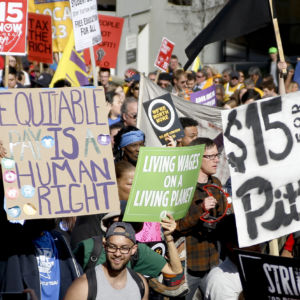Fight for $15 protesters took to the streets of downtown Chicago to protest Tuesday against McDonald’s ahead of its annual shareholders meeting.
The Fight for $15 movement has been at the forefront of the minimum wage debate since it started in November 2012. It has advocated for the minimum wage being increased to $15 an hour. McDonald’s is scheduled to hold its shareholders meeting Wednesday on the outskirts of Chicago.
The protesters marched through the streets before eventually surrounding the site where the new McDonald’s headquarters is being built. The protesters also marched on Daley Plaza outside Trump Tower in Chicago. The Fight for $15 movement has been highly critical of President Donald Trump.
“We’ll be in the streets in full force, joined by major resistance groups from around the nation, as shareholders arrive for their annual meeting at McDonald’s headquarters,” Fight for $15 stated on its website before the protest. “There’s no chance in hell the billionaire class will miss us as thousands march to demand $15/hr and union rights.”
Service industry jobs have been known to help younger and low-skilled workers enter the labor market. Those job opportunities, however, also tend to receive lower pay. While some argue the minimum wage should be increased to help these workers, others fear it could have severe unintended consequences. McDonald’s has also established training and educational programs to help their workers develop additional skills.
“Our commitment to the communities we serve includes providing opportunities for those who work in our restaurants to succeed at McDonald’s and beyond,” a McDonald’s spokesperson said in an email to InsideSources. “In just two years, we are proud that over 17,000 employees have participated in this extended learning. Together, these important investments in our people show why we are committed to being America’s best first job.”
The Fight for $15 has argued McDonald’s is emblematic of a greater corporate greed problem. It has been highly critical of other large franchises, retailers, and corporations. Movement organizers even compared McDonald’s to President Trump, who they claim has also disenfranchised lower income individuals.
The Fight for $15 and other supporters argue the policy could help lift low-wage workers out of poverty. They have argued the current federal minimum wage of $7.25 an hour is too low for people to reasonably live on. The increase might also spur economic growth through a rise in spending.
Those opposed to the increase warn it will actually hurt the poor by reducing employment opportunities. Employers could be forced to reduce employment or increase prices to overcome the added cost of labor. Some critics have even expressed concern that the movement backers have alternative motives.
Seattle became the first place to pass the $15 minimum wage in June 2014. It was later adopted by dozens of cities across the country. New York and California became the first and only states to pass the increase this past year. The movement has also worked to increase the federal minimum wage which hasn’t been updated since 2009.
The Fight for $15 movement is primarily supported by labor unions like the Service Employees International Union (SEIU). Some critics have contested the movement isn’t grassroots but rather a ploy by unions to recruit. The Center for Union Facts released a report April 3 which found the union spent over $19 million on the Fight for $15 last year.
“Today’s protests were organized by out-of-touch left-wingers who are upset that their disastrous policy proposals continue to go nowhere,” Jeremy Adler, communications director for the conservative nonprofit America Rising Squared, told InsideSources. “SEIU is funding this effort, not out of an interest in helping workers, but only so they can try to acquire more dues-paying members, and waste their hard-earned money on rejected political activities.”
The National Bureau of Economic Research and The Heritage Foundation found the increase will have a significant negative impact on employment. They found the risk is especially bad for young and low-skilled workers. The University of California, Berkeley found any losses would be marginal compared to the potential benefits.
Fight for $15 did not respond to a request for additional comment by InsideSources.

